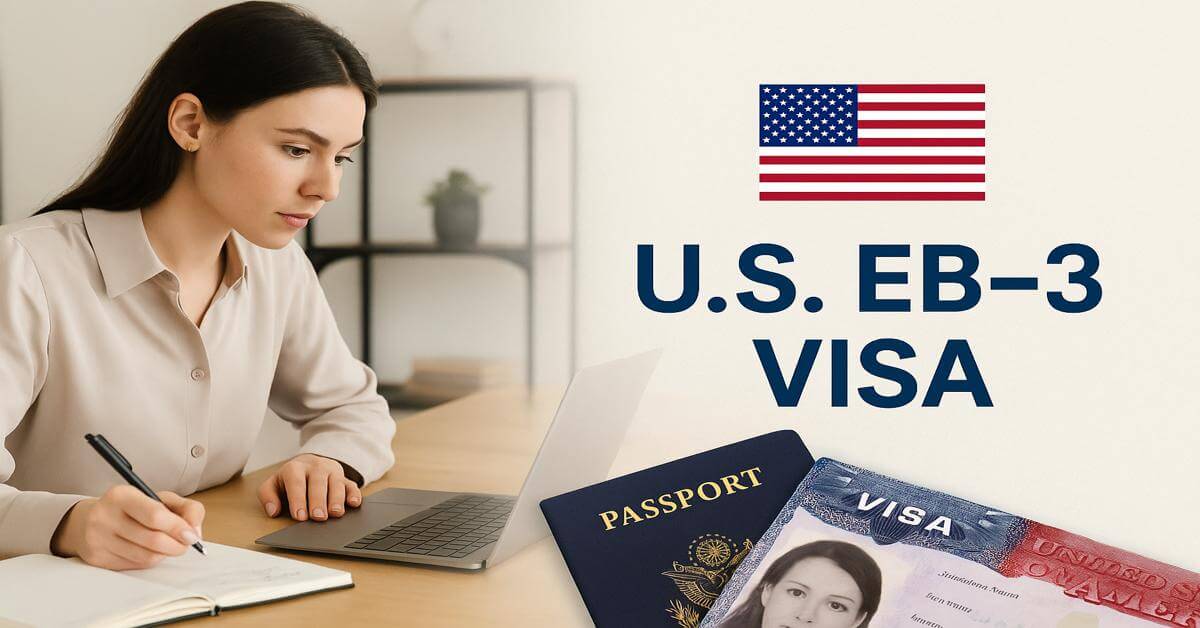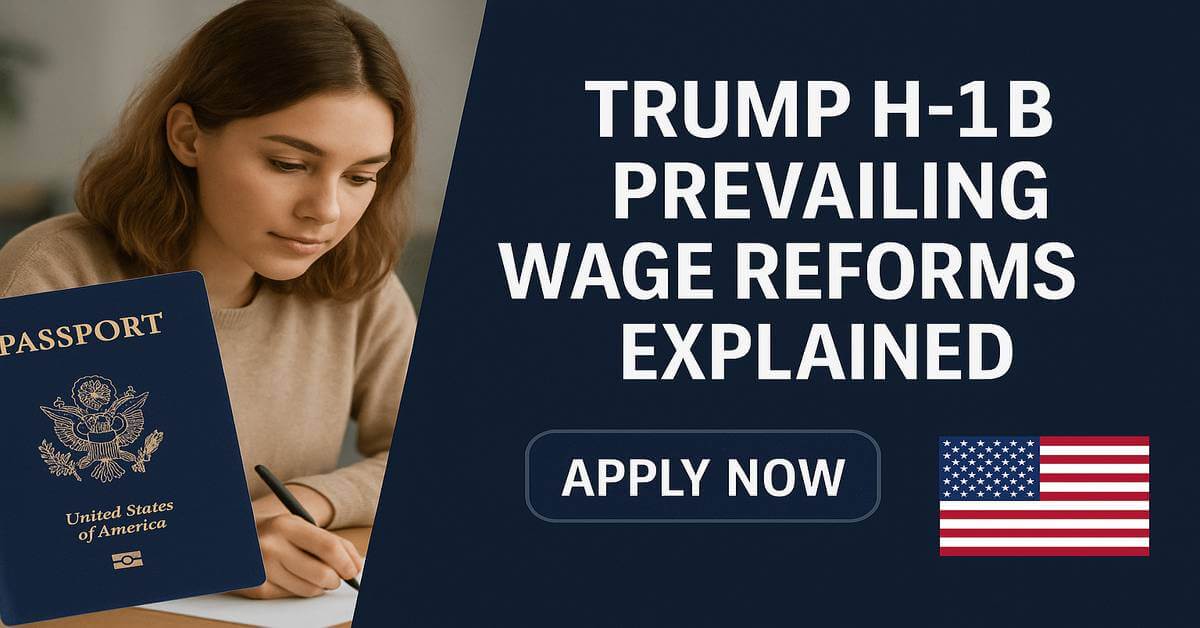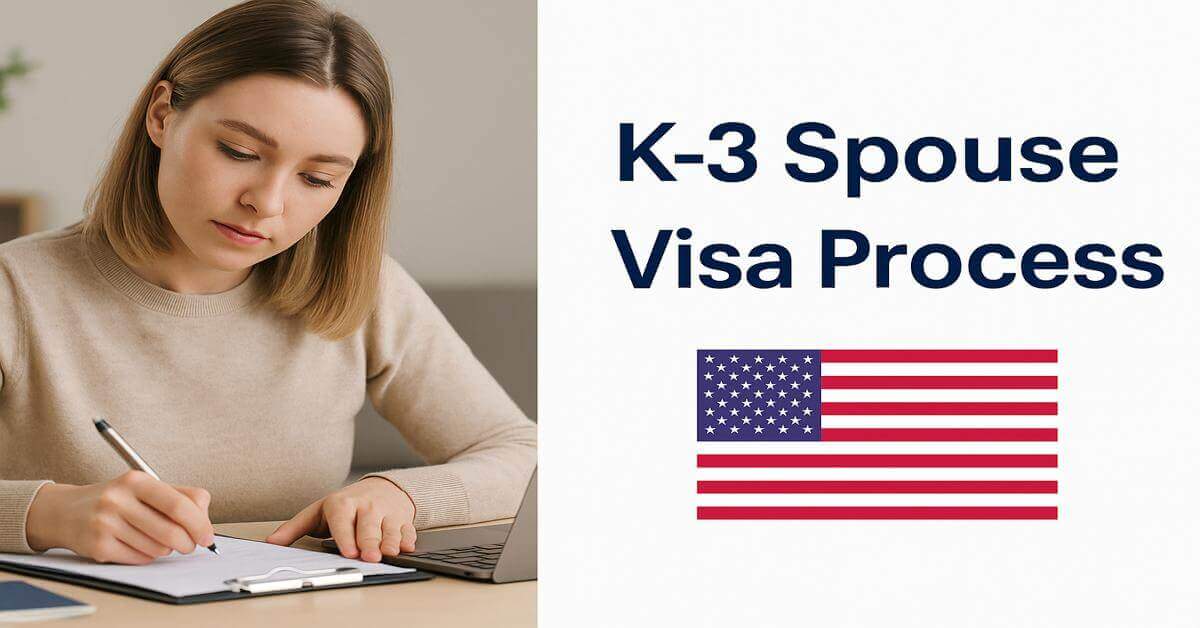The EB-3 visa is a U.S. employment-based green card category designed for skilled workers, professionals, and unskilled laborers with a valid job offer from a U.S. employer. It remains one of the most accessible immigrant visa options for foreign nationals seeking permanent residency in the United States.
This guide explains the eligibility requirements, application steps, costs, processing time, and how to bring your family under the EB-3 category. Whether you’re applying from abroad or adjusting your status within the U.S., this comprehensive resource walks you through every stage of the EB-3 immigration process
Categories:
It’s part of the third preference category of employment-based immigration, covering three groups:
- Skilled Workers (with at least two years of relevant training or experience)
- Professionals (with a U.S. or equivalent foreign bachelor’s degree)
- Other Workers (performing unskilled labor requiring less than two years of training)
EB-3 Visa Cost:
| Category | Form | Fee |
|---|---|---|
| Employer | Form I-140 | $715 |
| Applicants in the U.S. | Form I-485 | $1,440 |
| USCIS Immigrant Fee | $235 | |
| Applicants Abroad | DS-260 (green card app) | $345 |
| I-864 (Affidavit of Support) | $120 |
EB-3 Processing Time:
| Step | Timeframe (Average) |
| PERM Labor Certification | 7–12 months |
| Form I-140 (Regular) | 7.7 months |
| Form I-140 (Premium) | 15 calendar days |
| I-485 (Adjustment of Status) | 7–32.5 months |
| Consular Processing | 6–12 months post I-140 |
Country-specific backlogs: India, China, and the Philippines may face multi-year delays. Check the Visa Bulletin for current dates.
Eligibility Requirements:
EB-3(A): Skilled Workers
- Minimum of 2 years of relevant job experience or training
- Labor certification (PERM) from U.S. Department of Labor
- Full-time job offer from a U.S. employer
EB-3(B): Professionals
- U.S. bachelor’s degree or foreign equivalent
- Job must require a degree
- Labor certification required
EB-3(C): Other Workers
- Less than 2 years of experience required
- Labor certification
- High demand in sectors like caregiving, food service, housekeeping, and farming
Read Also: U.S. EB-1 Visa Explained – Immigration Path for Individuals
EB-3 Employment-Based Green Card:
The EB-3 employment-based green card is a U.S. immigrant visa that allows foreign nationals to become lawful permanent residents (green card holders) through job offers in the United States. It falls under the third preference category of employment-based immigration and is ideal for skilled workers, professionals, and unskilled laborers.
Eligibility Categories:
- Skilled workers: Minimum 2 years of job experience or training
- Professionals: U.S. bachelor’s degree or foreign equivalent
- Unskilled workers: Less than 2 years of training or experience
Key Steps in the EB-3 Process:
- U.S. employer obtains a PERM Labor Certification from the Department of Labor
- Employer files Form I-140 (Immigrant Petition)
- Beneficiary applies for green card through:
- Adjustment of Status (if in the U.S.)
- Consular Processing (if outside the U.S.)
Processing times vary but can take 12–36 months depending on country of origin and visa bulletin priority dates.
EB-3 Visa for Unskilled Workers:
The EB-3 unskilled worker visa (also known as “Other Workers” category) is a U.S. green card option for foreign nationals performing non-seasonal, permanent, full-time jobs that require less than 2 years of training or experience.
Examples of EB-3 unskilled jobs:
- Hotel housekeepers
- Factory and warehouse workers
- Farm laborers
- Nursing aides
- Food processing workers
Requirements:
- Permanent full-time job offer from a U.S. employer
- Employer must complete a PERM Labor Certification
- No formal education or degree required
Visa Process:
- Employer files Form ETA-9089 for labor certification
- Submit Form I-140 to USCIS
- Wait for a visa number to become available per the visa bulletin
- Apply for an immigrant visa or green card
Due to high demand, the wait time for EB-3 unskilled workers from some countries (e.g., India, China, Philippines) may be longer. However, many workers from other nations can proceed more quickly.
EB-3 Professional Visa:
The EB-3 professional visa is designed for foreign nationals who hold at least a U.S. bachelor’s degree or its foreign equivalent and have a job offer from a U.S. employer.
Who qualifies as a “professional”?
- Must hold a bachelor’s degree (or higher)
- The position must require a degree as a minimum entry requirement
- Must be offered a permanent, full-time job
Common EB-3 professional occupations:
- Engineers
- Accountants
- Teachers
- Marketing specialists
- Business analysts
Process Overview:
- Employer obtains PERM labor certification
- File Form I-140
- Green card application through consular processing or adjustment of status
Unlike the EB-2 category, the EB-3 doesn’t require showing national interest or an advanced degree, making it more accessible to qualified professionals worldwide.
EB-3 Skilled Worker Category:
Title: EB-3 Skilled Worker Category – Green Card Option for Experienced Workers
Content:
The EB-3 skilled worker category is for foreign workers with at least 2 years of job experience or specialized training, and a U.S. employer willing to sponsor them for permanent employment.
Key Requirements:
- Minimum 2 years of relevant work experience or vocational training
- Permanent full-time job offer in the U.S.
- Job must not be temporary or seasonal
- PERM Labor Certification required
Popular Skilled Worker Roles:
- Electricians
- Plumbers
- Welders
- Chefs and bakers
- CNC machine operators
- HVAC technicians
EB-3 Skilled Worker Process:
- Employer files for labor certification
- Submit Form I-140
- Wait for visa number availability
- Apply for green card
This category offers a practical green card path for tradespeople and technical workers who may not hold a degree but possess in-demand skills and job experience.
How to Apply for U.S EB-3 Visa 2025?
- PERM Labor Certification
Employer tests the labor market to prove no qualified U.S. workers are available. - Form I-140 Petition
Employer files this petition with USCIS to classify the worker as eligible for EB-3. - Visa Availability Check
Confirm visa category is current via Visa Bulletin. - Apply for Green Card
- Inside U.S.: File Form I-485 (Adjustment of Status)
- Outside U.S.: Submit DS-260 and attend a visa interview at U.S. consulate
- Green Card Issuance
After background checks, medical exam, and biometrics, the green card is approved.
EB-3 vs EB-2 vs H-1B:
| Feature | EB-3 | EB-2 | H-1B |
| Type | Green card (permanent) | Green card (permanent) | Temporary work visa |
| Education level | Low to moderate | Advanced (Master’s or higher) | Bachelor’s or higher |
| Labor Certification | Required | Required (unless NIW) | Not required |
| Wait times | Longer for India/China | Shorter (except India/China) | Quota-based; lottery system |
Pros and Cons:
Pros:
- Pathway to permanent residency (green card)
- Family members can accompany (spouse, children under 21)
- No lottery system (unlike H-1B)
Cons:
- Processing delays, especially for certain countries
- Employer sponsorship and labor certification required
- Job mobility limited during green card process
Additional Information:
- Check your country’s wait time on the Visa Bulletin regularly.
- Always work with a licensed immigration attorney.
- Ensure job offer meets the exact EB-3 category requirements.
- Consider EB-2 if you qualify, as it often has faster processing.
For official guidance, visit USCIS.gov or contact a certified legal expert.
Frequently Asked Questions:
-
What is the EB-3 visa?
The EB-3 visa is a U.S. employment-based immigrant visa for skilled workers, professionals, and unskilled workers. It grants lawful permanent residency (a green card) to qualified foreign nationals with a valid job offer from a U.S. employer.
-
Can I bring my family on an EB-3 visa?
Yes, your spouse and unmarried children under 21 can also apply for green cards as your dependents.
-
What happens if my priority date retrogresses?
You must wait until it becomes current again to proceed with adjustment or visa issuance.





